Corn Growth and Management Quick Guide (A1173, Revised May 2020)
Knowing the growth stages and growth processes of corn allows growers to time field operations properly to meet windows of opportunity. Proper timing of fertilizer, irrigation, cultivation, harvest and pesticide application can improve yields significantly.
Another less common method is similar but does not count the first emerging leaf, only the later, pointed-tipped leaves. A third method of staging commonly is used by the crop insurance industry and simply counts all leaves visible, whether rounded or pointed and collared or not.
Knowing the staging method used to describe the stage of plant growth is essential. Herbicide labels that don’t refer to the leaf-collar method may (or may not) skip counting the first true leaf (rounded-tipped leaf). To clarify, some labels may refer to the height of the weeds for application timing.
Being off one or two leaf stages due to differing descriptions may not always be critical, but it can lessen the treatment benefits and create confusion in interpreting labels, troubleshooting problems and dealing with others, such as insurance adjusters.
Vegetative Growth Stages
1. Germination and Emergence (VE)
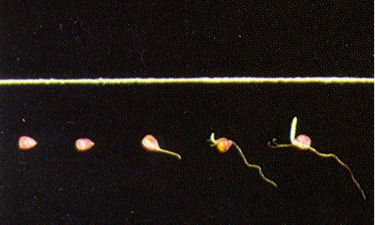
- Figure 1. Germination progression through six days after planting.
Corn seed begins germination when the seed contains at least 30% moisture. The first seedling structure to emerge from the corn seed is the radicle (root), followed by the coleoptile (shoot) with the enclosed plumule (first leaves and growing point) (Figure 1).
Emergence of the radicle first allows the young seedling to anchor in the soil and obtain an adequate supply of water and later obtain water and nutrients. To emerge, the first internode on the corn plant (the mesocotyl) elongates toward the soil surface and continues until the coleoptile reaches light. If not planted too shallowly, the crown of the corn plant usually establishes at about ¾ inch from the soil’s surface.
Imbibitional chilling injury, which is caused by the seed imbibing water that is much less than 50 degrees within the first 24 to 36 hours after planting, can cause seed death, damaged radicles, corkscrewing of the mesocotyl and death to the seminal root system. Planting corn only when soils will be warmer than 50 degrees during the first 24 hours after planting is recommended to reduce the risk.
At the VE stage, the growing point, which is just above the crown, is normally about ¾ inch below the soil surface. Corn emerges after the accumulation of about 125 growing degree days (GDDs). Each new leaf takes 80-85 GDDs to emerge. The growing point remains below the soil surface for three to four weeks, protecting this growing point from physical injury, including frost, surface insects or grazing animals.
2. V1 to V2
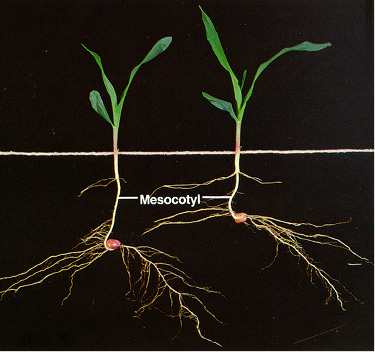
- Figure 2. V2 plant.
These growth stages occur about one week after the plant emerges. Because the root system is relatively small and the soil is cool, fertilizer nutrients stimulate early plant growth. However, the amounts of nutrients required are relatively small, and fertilizer placed in a band where the primary roots will contact it will allow effect uptake at this stage. The seedling (seminal) roots of the corn plant in the first whorl (groups of roots arising from a node) are elongating.
3. V3 to V5
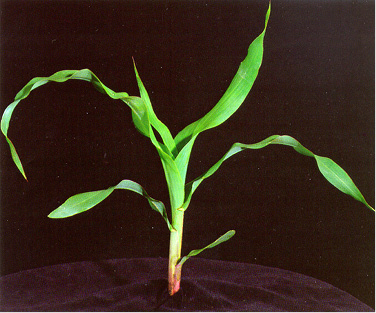
- Figure 3. V3 plant.
Two to three weeks after the plant emerges, the V3 stage begins. A frost (light freeze) or hail may destroy the exposed leaves but will not damage the growing point below the soil surface, so damage to the plant above the soil surface at this time usually results in very little reduction in yield.
Growth of the seedling root system essentially has ceased. The nodal roots have begun to establish. The roots of the second whorl are elongating. The nodal roots now form the major part of the root system. These are the small upper roots in Figure 2. Leaf and ear shoots are being initiated and this initiation will be complete by V5 (potential ear shoot number is determined).
Also by V5, a microscopically small tassel is initiated at the growing point. The above-ground plant height is about 8 inches when the tassel is initiated, but the growing point is still at or just under the soil surface. However, soil temperature can affect the growing point. Cold soil temperatures can:
- increase the time between leaf stages
- delay tassel formation
- reduce nutrient uptake
Weeds also are competing for water, nutrients and light. Corn is quite sensitive to competition from weeds at this stage of development.
4. V6 to V7
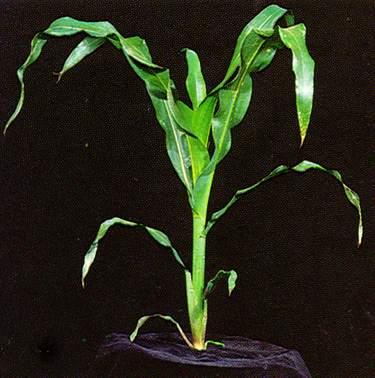
- Figure 4. V6 plant.
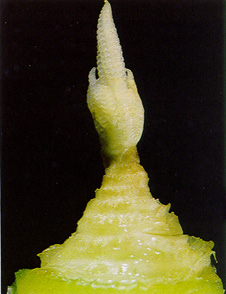
- Figure 5. Magnified tassel of V7 plant.
Three weeks after the plant emerges, the plant enters the V6 stage. The root system is well-distributed in the soil and extends about 18 inches in depth and 24 inches in radius. The third root whorl is elongating. The plant is absorbing greater amounts of nutrients rapidly, so ensuring adequate nutrient levels in the soil with a proper fertility program is critical so that crop growth is not limited.
The growing point is above the soil surface and rapid stem elongation begins. Some tillers (suckers) may have initiated. Sucker development varies with hybrid, plant density, fertility and other environmental conditions.
Row-applied fertilizer is less critical now as nodal roots have proliferated throughout the soil. Nitrogen can be side-dressed up to V8 if placed in moist soil, and excessive root pruning and injury of above-ground plant parts are avoided.
5. V8 to V9
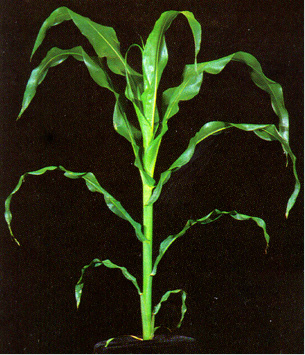
- Figure 6. V9 plant.
Four weeks after the plant emerges, it enters V8. Nutrient deficiencies, if present, become more obvious. Nutrient deficiencies at this stage seriously restrict leaf growth. Corn can respond to “rescue” applications of some nutrients (e.g. N, K, S and Zn) at this stage, although applications may require high-clearance equipment so the crop is not damaged.
The fourth whorl of nodal roots is elongating. Several ear shoots are present. A potential ear shoot will form at every above-ground node except the upper six to eight. Initially, each ear shoot develops faster than the one above, but growth of the lower ear shoots slows. Only the upper one or two ear shoots eventually form harvestable ears.
Prolific hybrids tend to form more than one harvestable ear, especially at lower plant populations. Removal of all the unfurled leaves of the plant at this stage (by frost or hail) may result in a 10% to 20% reduction in final grain yield.
Flooding at this or any earlier stage when the growing point is below ground can kill the corn plants in a few days, especially if temperatures are high. Flooding at later stages, with the growing point above the soil surface, is not as detrimental.
6. V10 to V11
Five weeks after the plant emerges, it enters V10. The corn plant begins a steady and rapid increase in nutrient and dry-matter accumulation. The time between the appearance of new leaves is shortened after the V10 stage to about 50 GDDs per leaf, with a new leaf appearing every two to three days.
Demand for soil nutrients and water are relatively high to meet the needs of the increased growth rate. Moisture and nutrient deficiencies at this stage will influence the growth and development of the ears markedly. Dry surface soils may limit the availability of nutrients that were applied to the surface zone and that are not mobile. Plants are susceptible to green-snap (breakage by high winds) at this stage through tasseling.
7. V12 to V13
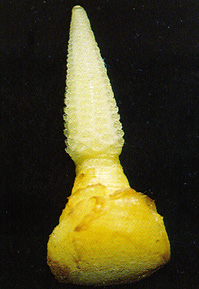
- Figure 7. Magnified top ear of V12 plant.
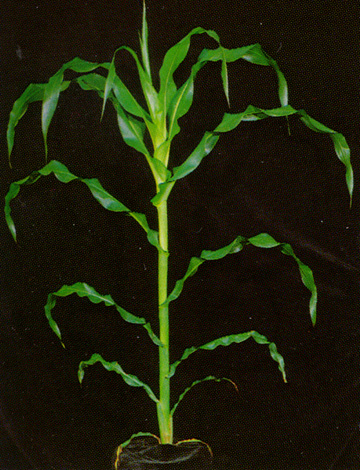
- Figure 8. V12 plant.
Six weeks after the plant emerges, V12 begins. Moisture or nutrient deficiencies may reduce the potential number of seeds on the cob by limiting the length of the cob and thereby seriously reducing the number of kernels per row. The kernel number per cob is determined during the period from V10 to V17. The length of time for the plant to develop through these stages affects harvestable yield.
Early maturity hybrids normally progress through these stages in less time and have smaller ears than later hybrids. Brace roots are developing from the fifth node (first above-ground node).
8. V14 to V15
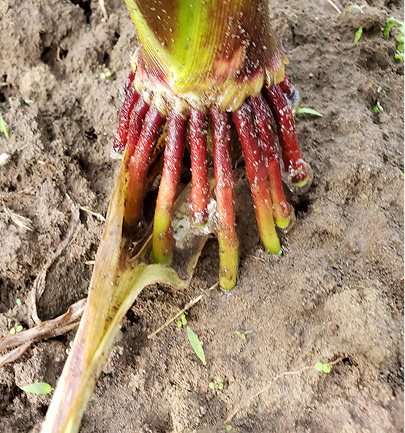
- Figure 9. Brace roots.
Seven weeks after the plant emerges, V14 begins. The corn plant at V15 is only 12 to 15 days away from R1 (silking). This vegetative stage is the most critical period of seed yield determination. The number of ovules that develop silks, and thus the number of kernels, is being determined. Any nutrient or moisture deficiency or injury (such as hail or insects) may reduce the number of kernels that develop seriously.
The tassel is nearly full size but not visible from the top of the leaf sheaths. Silks are just beginning to grow from the upper ears. A new leaf stage can occur every one to two days.
Brace roots from the sixth node are developing, and the permanent roots have continued to elongate and proliferate, eventually reaching a depth of about 5 to 8 feet and spreading several feet in all directions.
9. V16 to V17
Eight weeks after the plant emerges, it is entering the late vegetative stages. The earliest maturing hybrids used in North Dakota may develop only 16 leaves. Because of high transpiration rates by the crop at this stage, drought stress can develop quickly if soil moisture is limited.
Moisture stress two weeks before or after silking can cause a large grain yield reduction (Table 1). In general, this is true for other types of environmental stresses (hail, high temperature, nutrient deficiencies) during this time.
Tips of upper-ear shoots may be visible at the top of leaf sheaths by V17 in hybrids that develop more than 16 leaves. The tip of the tassel may be visible in the early maturing hybrids. The four-week period around silking is the most effective time for irrigation if the water supply is short.
Table 1. Yield Reduction in Corn Due to Drought
|
Age of the |
Stage |
Yield Reduction per Drought Day (%) |
% Total Reduction |
|
1-33 days* |
VE-V5 |
— |
— |
|
Next 22-32 days |
V6-V15 |
2.0 |
25 |
|
Next 5-15 days |
V16-R2 |
6.0 |
50 |
|
Next 20-30 days |
R3-R5 |
1.5 |
25 |
|
Next 5-15 days |
R6 |
— |
— |
|
*Yield reduction depends on many variables, including germination and upper soil profile moisture. Overall drought period will affect yield reduction. A continuous drought may result in 100 percent reduction. |
|||
10. V18 and other numbered vegetative stages that may follow
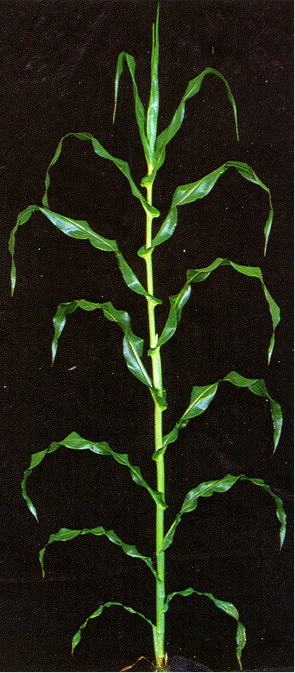
- Figure 10. V18 plant.
Silks from the basal ear ovules have been the first to elongate, followed by silks from ovules above them, and ending with the silks from the ear tip ovules. Brace roots are growing from above-ground nodes and can provide support to the plant and reduce the risk of lodging.
Ear development is continuing rapidly, with the plant only one week away from viable silking. Stress in these later vegetative stages will delay the beginning of silking more than the beginning of pollen shed (which might cause the corn to delay silking until pollen shed is partially or completely finished, causing the nick to be missed). Unfertilized ovules result in missing kernels on the ear, especially at the ear tip.
11. VT (tasseling)
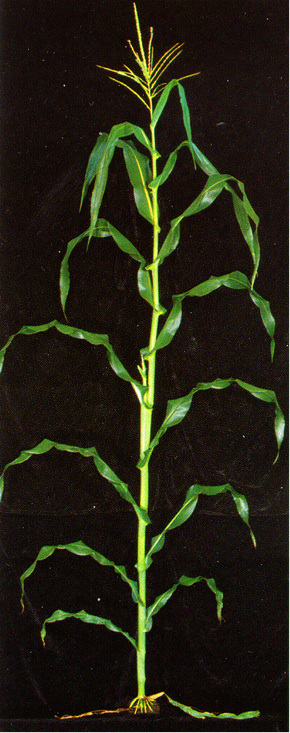
- Figure 11. VT plant
Stage VT occurs two to three days before silking, when the last branch of the tassel is completely visible but silks have not emerged yet from the ear shoot. The plant has reached full height and the pollen shed begins. The time between VT and R1 can vary with different hybrids and due to environmental conditions. All leaves have emerged.
Pollen shed (pollen drop) normally occurs during the late morning or early evening. Hail damage is more serious at this time than for any other growth period. The complete loss of a pollen source would result in no grain formation.
Table 2. Critical Field Corn Growth Stages
|
Growth Stage |
Days after Emergence |
Growth Event |
Importance |
|
V3 |
9-12 |
Nodal root system and ear shoots initiated |
Seedling vigor seen, ears established |
|
V4 to V5 |
14-21 |
Ear shoot initiation complete |
Number of kernel rows determined |
|
V6 |
21-25 |
Nodal root system established |
Plant’s ability to take up nutrients and water established |
|
V12 to V14 |
42-49 |
Number of ovules determined |
Number of kernels per row determined |
|
R1 (silking) |
63-68 |
Brace roots establish; pollen shed begins |
Kernel fertilization, support ear weight, kernel fill |
Reproductive Stages and Kernel Development
1. R1 Silking
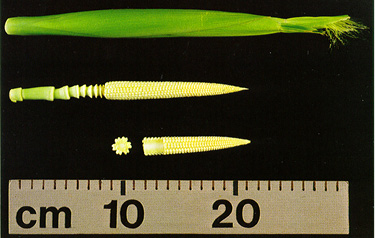
- Figure 12. R1 ear and shank.
The plant is about 55 to 66 days after emergence. This stage begins when silks are visible and pollination occurs. Pollination is when pollen grains contact the new, moist silks.
A pollen grain grows down the silk and fertilizes the ovule in about 24 hours. Upon this fertilization, the ovule is a kernel. Silks grow about 1 to 1.5 inches per day and continue growing until fertilization.
Normally, for all silks on a single ear to emerge and be pollinated takes two to three days. Moisture stress or nutrient deficiency will result in poor pollination and seed set. The largest yield reduction occurs with stress at silking (early R1).
Potassium uptake is essentially complete, and nitrogen and phosphorus uptake is rapid in the plant.
2. R2 Blister
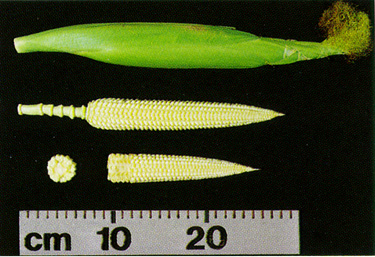
- Figure 13. R2 ear and shank.
This stage is about 12 days after silking. The kernels are white and contain a clear liquid. The cob is close to full size. Silks darken and dry.
Irrigation, if needed, can ensure adequate moisture for grain production. Starch is just beginning to accumulate in the watery endosperm (the kernels are about 85% moisture). Kernels are in a steady and rapid period of seed-fill (continues to R6).
3. R3 Milk
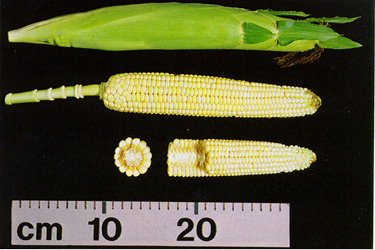
- Figure 14. R3 ear and shank.
This stage is about 20 days after silking. Kernels are beginning to yellow (for yellow corn) on the outside but contain a milky white inner fluid (starch accumulation; the kernel is at about 80% moisture). Most of the kernels have grown out from the surrounding cob material.
The endosperm (the starchy center of the kernel) division in each seed is complete and growth will be due to cell expansion and starch accumulation. Stress is not as severe at R3 as at R1; however, yield reduction can occur due to a reduction in the number of kernels that ultimately develop and to the final size and weight of the kernels. Very little root growth occurs after R3.
4. R4 Dough
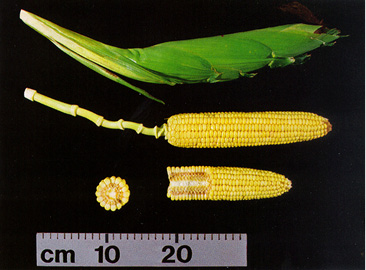
- Figure 15. R4 ear and shank.
This stage is about 26 days after silking. The kernel has thickened to a pasty (doughy) consistency from the earlier milky state (starch has continued to accumulate). The embryo of the seed is growing while the kernels are just beginning to dry at the top (dent).
Kernels have accumulated 50% of their dry weight and have about 70% moisture. Unfavorable environmental conditions or nutrient deficiencies still can result in unfilled kernels and “chaffy” ears.
5. R5 Dent
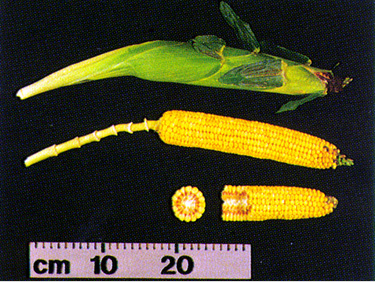
- Figure 16. R5 ear and shank.
This stage is about 36 days after silking. For dent types, nearly all kernels are dented or denting. Drying kernels show a small, hard, white layer on top. A white line (known as the milk line or starch line) can be seen across the kernel shortly after denting (starch line position indicates maturity; it will advance toward the kernel tip with maturity).
Stress at this point can reduce kernel weight but not kernel number. A hard frost can stop dry-matter accumulation and cause premature black layer formation (Table 3).
Yields also may be influenced due to field losses from frost-damaged ears, which are slower to dry and delay harvest. (This indicates hybrids that are mature at least seven to 10 days before the average first killing frost date should be selected).
Kernels at this stage have about 50% to 55% moisture. At around 48 days after silking, all the kernels should be fully dented. The seed embryo is morphologically mature. Dry-matter accumulation in the kernels will cease soon.
Table 3. Corn Grain Frost Injury Yield Reduction
|
Kernel |
Kernel Moisture |
Days |
Days to PM* (R6) |
Yield |
|
R4 – Dough |
70% |
26 |
31-37 |
35-50% |
|
R5 – Dent |
50% |
36 |
20-23 |
10-20% |
|
R5.5 – Mid-dent |
40% |
48 |
10-12 |
4-5% |
|
R6 – PM* |
30-35% |
55 |
0 |
0% |
|
*PM is physiological maturity (black layer). |
||||
6. R6 Physiological Maturity
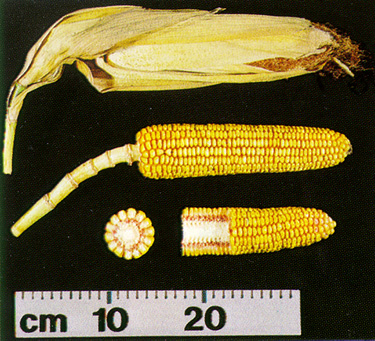
- Figure 17. R6 ear and shank.
This stage is about 55 days after midsilk. All kernels have attained maximum dry weight. The starch line has advanced completely to the kernel tip and a brown or black layer is present (black layer progresses on the ear from the tip kernels to the basal kernels in about 10 days).
Harvest for silage can be done now or slightly earlier, but grain harvest will require more drying. Husks and many of the leaves are no longer green, but the stalk may be green. At black layer, the average kernel moisture is 30% to 35% (averaged across hybrids and environmental conditions).
At 20% to 26% moisture, grain harvested still will need artificial drying to be stored safely; thus, more field dry-down often is used (rate of field dry-down varies with hybrid and environmental conditions). Shelled corn can be stored safely at 13% to 15% moisture.
Photos for this publication were provided through the Iowa State University Photo Service, J.C. Herman, editor, with technical assistance from S.J. Lupkes. The stage designation format was derived from Iowa State Extension special report 48, “How a Corn Plant Develops,” prepared by S.W. Ritchie, J.J. Hanway and G.O. Benson. Also, qualifications on production management suggestions were summarized from lectures of J.R. George at Iowa State University.
This publication was authored by Duane Berglund, professor emeritus and former Extension agronomist, NDSU; Gregory Endres, Extension cropping systems specialist, NDSU; and D.A. McWilliams, formerly of the University of Minnesota and NDSU, 1999.

